"JACK GAYLOR, THE INTREPID"
By Donald Earl McKinney, Jr
Introduction:
The title of this article was inspired by an old Fremont Clipper newspaper article dated May 26, 1893. This particular paper had an interesting account of Sheriff Stough and his posse capturing the escaped prisoners Carr and Nutcher near Skull Gulch, a tributary of Twin Creek, about 25 miles from Lander. In the Local Department section of this issue was the following:
"JACK GAYLOR, THE INTREPID, LENT A HELPING HAND IN THE ENDEAVER TO CAPTURE THE FLEEING PRISONERS."
When I read this xerox copy of the old Clipper, I was absolutely thrilled. Being a little unsure of the exact meaning of the word "intrepid", I looked it up in a dictionary. According to that dictionary, the word meant "brave or fearless in the face of danger." Since I began my family research several years ago, I had accumulated quite a bit of interesting information concerning my Great-Great Grandfather and this and other little tidbits from other issues of the Clipper
provided the "icing on the cake."
When I first began my research, I didn't even know the name of my
Great-Grandmother, Nora (Gaylor) McKinney's father. No one in my family seemed to know much about him. Through the help of some distant cousins and other relatives, I was able to put bits and pieces together and finally realized that he was somewhat of a "family mystery." My Grandfather, Earl McKinney, was a cattle rancher and lived in Fremont County all of his life. I didn't get a chance to talk to him before he died about his Grandfather, Jack Gaylor, but he was only 3 years old is Grandfather left for the Spanish American War and may not have had much specific information to offer. Jack Gaylor never returned to his home and family in Wyoming after the war, however his children and grandchildren remained in Fremont County for many years. Jack Gaylor has been "lost" for the last 80 or so years and the family tradition held that when he never returned home after the war, he was never heard from again by his children except for notification that he was in a hospital in San Francisco soon after the war. The family made every effort through the American Red Cross and War Department to learn his fate with no success. It is said that his son, Walter Gaylor, searched for his father in California soon after the war, but could find no trace at all. After a couple of years of searching and researching, I finally located a death certificate for Jack Gaylor which indicated that he was Assistant Chief Park Ranger in Yosemite National Park, California and he died there on 19 April 1921. This was long after the Spanish American War ended. A search of the retired personnel files of the Department of the Interior in St Louis, provided documentation that proved this was my Great-Great Grandfather. This was too late for his son and two daughters who have long since passed away, but I felt a certain sense of self satisfaction in finding my long lost ancestor. In the meantime, I have uncovered some more information which gives us more of an idea of what type of person he was and the type of life he led. Why he never returned to Wyoming will never be known for sure and will remain a mystery forever.
In Cheyenne, he found employment as a stage driver for the Rooks and Bowman freighting outfit. He drove a stage from Cheyenne to Deadwood, South Dakota for two years and according to his daughter Nora McKinney's biography on file in the archives at Cheyenne, he was "quite proud of his six-horse outfit when he drove in the direction of the Black Hills region." He also made several freighting expeditions from Cheyenne through the Black Hills to Fort Pierre, South Dakota and back to Cheyenne. He was a young 26 year old man in the prime of his life. During this 1876-1878 period when Jack drove this Cheyenne and Black Hills trail, the area was notorious for numerous robberies and hostile Indian attacks. Also during this period, Calamity Jane is said to have driven a stage along that route and Wild Bill Hickok made his famous trek from Cheyenne to Deadwood.
Around 1878 Jack Gaylor met John and Tom Durbin who owned a large ranch near Cheyenne. It is quite possible he met them while driving the stage, because the Durbin brothers invested in a gold mine in the Black Hills in 1876 and made several stage trips from Cheyenne to Deadwood during the late 1870's. An account of one of these trips was published in Cheyenne and Black Hill Stage and Express Routes, by Agnes Wright Spring. This trip was described in a 1936 interview with Tom Durbin's wife who made ;the trip by stage with her brother-in-law John Durbin. The following are
"We went through Red canyon where the Metz family had been killed. They
said Indians had killed them, but I'm sure that it was road agents disguised as Indians.------------Word came that the stage was attacked last night by road agents. They shot Johnny Slaughter through the heart. The horses ran away. Johnny's father was marshal here in Cheyenne at the time. There were buckshot holes in the stage when it came into our station. We transferred into it though and sat there
trembling as we looked at the bullet holes.--------------As we came around a curve, someone said "Look up there." We could see a man off his horse in a long ulster, behind a cluster of trees. There was a log across the road. With the help of some of the passengers, the dirver rolled it off like lightning and drove on."
Anyway, Jack Gaylor became well acquainted with the Durbin brothers and went to work for them as a cowhand in 1878. According to the History of Cheyenne and Northern Wyoming, by J.H. Triggs, the Durbin brothers had 1500 cattle, 410 horses and mules and 2500 sheep. Jack worked long hard hours each day as he broke horses and tended the cattle. A cowboy's life, especially back in those days, was not a glamorous occupation,but was rough and dirty. However, the tradition of the American cowboy remains to this day a fascinating part of the "romance of the west." Jack soon established his own ranch. He leased part of the Durbin spread and ran cattle on shares with the Durbin brothers with success. In 1880, Jack found employment with the War Department as a scout and wagonmaster/teamster at Fort Washakie. This was the year he evidently came to Fremont County. He made many trips with the cavalry escorted freight outfits that departed Fort Washakie and hauled and supplied materials to the various cavalry outposta and other government agencies throughout Wyoming. He served the War Department at Fort Washakie for 2 years but in 1882 Jack became restless and again decided to seek his fortune in the gold mines. This time he decided that a trip to the gold fields of New Mexico might prove financially rewarding. He left New Mexico when the Indians became too dangerous and headed for Boulder, Colorado, but soon returned to Fremont County. He moved his family to South Pass where he established some mining claims in 1883. He also found employment as a freighter in the vicinity of South Pass and Lander.
With gold mining out of his blood, Jack Gaylor decided to establish a homestead in 1885 in the scenic Sinks Canyon area along the Big Popo Agie River near Lander. Jack and Sarah had 2 daughters and 1 son and when Sarah died on the Sinks Canyon homestead the day after Christmas in 1886, Jack was left with the responsibility of raising 3 young children by himself. His wife was buried in the old Borners Garden cemetery. One other daughter, Emma, died in infancy in Cheyenne. Before his wife
died, Jack constructed a nice log house for his family and made many other improvements on the land which was required by the Homestead Act. Many years later, during the 1900's, this homestead was owned by the Herbert States family
"The Clipper, Lander, Fremont County, Wyoming, Sept. 17, 1887"
"The Clipper, Lander, Fremont County, Wyoming, Nov 5, 1887"
"The Clipper, Lander, Fremont County, Wyoming, Feb. 11, 1888"
Jack soon developed a nice apple orchard on the homestead. From the Fremont Clipper, September 17, 1887:
Jack's close friends and neighbors and witnesses on his homestead application were John Hornecker, Jacob Meyer, Frank NIchols, and James Carr. Another close friend and neighbor was Johnny Borner who lived just a few miles down the river. Johnny's wife Lena was a sister to the infamous Calamity Jane. Jack was also closely associated with Ernest Hornecker, Jake Frey, Charlie Fogg and many others in the Lander area. The old Johnny Borner place was where Jack's daughter Nora McKinney
and her family eventually made their home. Jack's other daughter Abigail Annabelle (or Abby) married Charles Rhodes in 1893. Walter Gaylor (born 1881) was the youngest child and was 17 years old when his father joined Torrey's Rough Riders (2d U.S. Volunteer Cavalry) as a civilian packmaster and left for the Spanish American War.
Jack seemed to be a well known and popular man in the Lander area and was quite sociable, but he wasn't afraid to express his opinions on occasions. The following is from The Fremont Clipper:
December 12, 1890-"Over twenty-five couples enjoyed a party at the home of Jack Gaylor last Saturday night."
Before he left for the Spanish American War and before his 2 daughters were married, Jack met a widow lady from Lander named Margaret Rutledge. He married her on November 4, 1890, but she deserted him after a year of marriage. According to the divorce papers filed by Jack Gaylor, Margaret could not get along with the 2 daughters. Margaret told Jake Meyer that she did not intend to "go back unless he came after her and made some other arrangements, that she would not live there with his
daughters." Also, according to the divorce papers, Jack was away on business much of the time during the year 1891 and was unaware of the personality conflict between the 3 women. He remained faithful to his children and divorced Margaret on grounds of desertion. Abbie Gaylor's daughter, Georgia Hulett of Dubois remembers her mother telling her how this step-mother was cruel to Nora and made her do all of the work. Of course there are two sides to every story and it is possible that part of the problem was the failure of the children to accept Margaret as a substitute to their mother who died 4
years earlier. Jack Gaylor was also well known throughout Fremont County as a hunter and trapper. He provided meat for his family and supplemented his income by selling the pelts of the animals he killed. The following items were found in The Fremont Clipper and The Clipper:
July 18, 1890 - GAYLOR AND THE BEAR: The days of the frisky and ferocious bear in the vicinity of Lander are by no means over, as witnessed the following statement of Jack Gaylor. Late Saturday night,, he was awakened from his peaceful slumbers by the barking of his dogs, which seemed to
proceed from near one of his out buildings in which Jack had shut up one of his pigs; the pig likewise was squealing at the top of its voice. Thinking the members of his domestic family were having some trouble he ran down to the to harmonize matters. Just as he got there, artd was going into the pen, there appeared to his astonished vision the figure of an immense bear, weighing at least 600 or 700 pounds, climbing right at him over the side of the pen. Mr Gaylor was not dressed to entertain such company, having left his gun at the house, and beat a hasty retreat, not asking the bear to follow. Returning a minute later with his weapon, he found that the bear had made his escape down the creek and Jack was unable to get another sight or shot at him, tho he spent some time hunting about with the dogs. Next morning he examined the tracks, which bore him out in the belief that his eyes had not deceived him, and that the bear was a big one; he also found tracks of another and smaller one. Picnic parties to the canyon may take notice, likewise bear-hunters in search of game.
January 21, 1888-"Jack Gaylor killed three elk and five mountain sheep last week."
August 8, 1890 - FATAL TERMINATION OF A PICNIC PARTY - Miss Gertrude
April 7, 1893-"A.J. Gaylor brought the pelt and horns of a very large mountain sheep to town last week. He sold it to W.A. Feiser who took it to Cheyenne to have it mounted. The animal was killed within ten miles of Lander."
March 4, 1898-"A.J. Gaylor of Rongis was in town Saturday and Sunday, having brought in a wagon load of coyote and wolf pelts. Mr Gaylor is one of the best wolf trappers in the state. He informs us that he will soon start for Klondike in company with two Colorado miners, who are now on Sweetwater getting together an outfit. They will go overland via Fort Union and expect to reach Klondike about the first of September."
Mar 4, 1898-"WANTED, TWO DOGS - I will pay $25 each for two Russian Wolf Hounds that will weight 140 pounds delivered to me at Rongis, Wyoming, or at James Graham's ranch on the Sweetwater. Want them in the next three weeks. A.J. GAYLOR, Rongis, Wyoming"
Jack Gaylor sold his homestead in 1895 and evidently moved to Rongis on the Sweetwater. His daughter, Nora McKinney and her husband Ed at the time operated the Upper Graham Ranch on shares with their good friend James Graham. This was at Meyersville, but they also had a desert land entry at Rongis and had horses in partnership with ranchers at Split Rock. Therefore, for a couple of years before leaving for the Spanish American, Jack visited quite often with his daughter and family on the Sweetwater. His other daughter Abbie and husband Charles Rhodes lived nearer Lander at this time, but later moved to Riverton. It appears that Jack didn't get the "gold fever" completely out of his blood, because according to that March 4, 1898 Clipper article, he had made plans to travel to Klondike. He never had his chance, because the Spanish American War started about that time and his adventurous spirit led him to
join Colonel Torrey and the "Rough Riders" as a civilian packmaster. He was nearly 50 years old at the time and had already raised his family, but the idea that he could see some action in Cuba probably appealed to him. The following item was in the August 12, 1898 issue of The Clipper:
"FROM THE ROUGH RIDERS, Camp Cuba Libre, Jacksonville, Fla., July 18,
1898; To the Editor of the CLIPPER
Jack soon transferred to the 7th Cavalry at Huntsville, Alabama and went to Cuba during the U.S. military occupation. While with the 7th Cavalry at Macon, Georgia, he met his third wife who was about 16 years his junior. They were very happily married for 22 years.
From The Clipper, February 10, 1899:
This was a very happy marriage for Jack and Elizabeth. She remained in Macon, Georgia while he went to the Philippines later that year. They had no children from this marriage, but Elizabeth stood by him and patiently waited for him to return from his adventures, just at his first wife Sarah did. He was Chief Packmaster under General Funston and was stationed at San Isidro, Mueva, Ecija, in the Philippines. The capture of Aguinaldo, the revolutionary President, by General Funston in March 1901 at Luzon virtually ended the main insurrection, and Jack returned to the States the following year.
Jack was later stationed at the Presidio of San Francisco and was in charge of the cavalry pack trains that brought supplies to the various outposts in Yosemite National Park. He gained some experience in Yosemite at fighting forest fires, planting fish and some other ranger type duties while on temporary duty. He became acquainted with Major H.C. Benson who was the Acting Superintendent of the park before the National Park Service was established. Because of Jack's natural abilities and his love of nature, he was perfect for this type of ranger position and was consequently appointed as a Park Ranger at Yosemite by the Department of Interior in September 1907. The pay was $900 a year. At this time there were only 6 of these permanent "first rangers" who had to patrol the entire Yosemite area.
1 Mar 1986 - (Merced Sun Star, Merced, CA) by Leona Lewis, Editor of Living Section Excerpts: "Horses hit by lightning in 1911 during a thunderstorm near Glacier Point in Yosemite Valley were ordered burned on the spot by the one and only ranger on duty. - - - - - - In 1911 a party of 10 women and 8 men felt the wrath of Mother Nature in Yosemite and lived to tell the story. The party of 18 sightseers traveled to Yosemite on horseback at a time before blacktop covered its roads and trails.- - - - - -On July 21, 1911, the caravan left the floor of Yosemite Valley - - - - -Just after they crossed Illilouette Creek, they rode by 370 foot Illilouette Falls, and were winding up the hill on a zig-zag trail when they came to a clump of tall pines. - - - - - -A bolt of lightning struck a nearby tree, then went down the trunk to the ground. This bolt either jumped across or passed along the ground. Anyway, it struck 10 mounted animals, killing seven horses and two mules. The riders were not hurt. - - - - the riders were insulated by their leather saddles. - - - -the lightning blew all the shoes off the horses - - - -According to reports,
seven horses fell with their hooves and legs pointing to the center of a half circle. - - - - -their jaws were cracked. - - - - --In 1911 there was only one ranger in Yosemite, JACK GAYLER. Staying with the party for 2 and a half days, he made them pile logs on the horses and burn all of them. Four five-gallon cans of kerosene were used to burn the horses - - - - -"
The following is from the History of the Sierra Nevada, by Francis P. Farquhar:
In his book, Guardians of the Yosemite, A Story of the First Rangers, retired Park Ranger John W. Bingaman wrote: "The ranger is the law, the information bureau, wild life protector, handy man, forest fire fighter and rescuer. In the first decadeof the Park Service beginning 1916, a Ranger was selected for his physical strength and
ability to ride and pack horses, to take care of himself along under all conditions and to see that the work assigned was accomplished.------------The "First Rangers" accomplished an unbelievable amount of work with little or no help. They spent many long days in the saddle patrolling, checking for violations, trespappers and fighting forest fires alone. They slept in the open with little or no shelter, lived on short rations and without telephones or radio facilities. It was their indomitable spirit
and love of the work which made the Parks what they are today."
The following are excerpts from Mr Bingaman's biographical account of Jack Gaylor as published in his book:
Jack Gaylor was about 75 years old when he died and was buried in Merced, California. During the summer of 1983, I decided to visit Yosemite National Park. I never dreamed anyone there would still remember my Great-Great Grandfather. I rolled into the entrance station at Tioga Pass and as I paid my fee to Ranger Ferdinand Castillo, I casually mentioned that my Great-Great Grandfather was a Park Ranger at Yosemite almost 80 years ago. He asked me what his name was and I replied, "Andrew J. Gaylor." HIs face absolutely flushed with astonishment and declared that the Gaylor Lakes, Gaylor Peak and Gaylor Basin were named after my Great-Great Grandfather. He seemed very thrilled as he "rolled out the red carpet" and acted as if I was some sort of celebrity. He introduced me to Park Naturalist, Dr Carl Sharsmith and to other rangers who recalled hearing stories of Jack Gaylor. When it was mentioned by Ranger Castillo that I was the Great-Great Grandson of Jack Gaylor, Dr Sharsmith exclaimed "Oh, Jack Gaylor. He would chase after trespassers in their "tin lizzies" by
horseback.He could catch them too!" I asked him if he knew Jack Gaylor and he replied "No, that was a little before my time, but I heard a lot about him." Ranger Castillo also took my picture in front of the Gaylor Lakes sign which was close to his cabin at the entrance station and told me, "This is your park." I made the mile and one half climb to the ridge which overlooks the Gaylor Lakes and the view of the Gaylor Basin was absolutely beautiful and was well worth the climb. I was totally exhausted when I got there since I was carrying my heavy video equipment and the altitude was very high. I refreshened myself with some snow which was still on the ridge and then hiked down to the lakes.
Letter from Terry Wehrman of Yellowstone National Park, Wyo to Tim McKinney of Lander, Wyo
5 Feb 1916 (Mariposa Gazette, Mariposa County, CA)
When I left Yosemite, Ranger Castillo gave me his personal copy of Mr Bingaman's book about the first rangers. He advised me that Mr Bingaman was still alove and gave me his address. Ranger Castillo
was very hospitable during my stay at Yosemite and I will always be grateful to him for his help. When I got back to Kansas, I wrote Mr Bingaman who was nearly 90 years old. He sent me a very enthusiastic reply and told of his experiences with Jack Gaylor. Mr Bingaman was a young man in the 20's when he knew Jack and was not a Ranger at that time. He told me he was quite proud when he was later appointed a Park Ranger at Yosemite and received Jack's badge number. A portion of Mr Bingaman's letter to me is as follows: "Jack as I remember was a tall, handsome man and when
you met him, especially while he was on patrol in the saddle, he was a man you never forgot, he was that "outstanding". He looked you straight in the eyes and you never forgot just what he was thinking. He was all for his love of the trails and mountains, always riding the trails and was on all trails of Yosemite National Park. He was a sight to see and I met him several times on the trails. I was working for the Yosemite Park and Curry Company at that time. So I was interested to see him and pass the day with him."
Jack Gaylor was a very charismatic, colorful, adventurous character and a self made man. He established his intrepid reputation while he was in Wyoming and his personality, one way or another, influenced those around him. Indeed, many of his exploits or adventures perhaps were not recorded or lost in ancient newspapers and publications that have not survived or have not been researched.
21 Apr 1921 - Merced Morning Sun, Merced, CA (Obituary)
Mr Stephen Mather, Director of the entire National Parks Service for the Department of Interior at Washington, D.C. during the 1920's, who was well acquainted with Jack Gaylor, sent a telegram to Jack's widow at Yosemite in which he stated: "You have my sincerest sympahty in your loss, which is also ours. Your husband's fine personality had endeared him to us all. His faithful service of over 14 years will always stand as a splendid record."
Andrew Jackson "Jack" Gaylor was representative of the many types of bold, hard working, long forgotten individuals who settled the West. I believe it is appropriate that this "long lost mystery man" has, through this publication, finally come home to Wyoming. To sum up his philosophy of life is the following message, attached to a gift, he gave his
son Walter before leaving for the Spanish American War: "Love many, trust few, and always paddle your own canoe."
END OF ARTICLE
THIS PAGE & MY ENTIRE FAMILY HISTORY DOMAIN IS PROTECTED BY AWARD WINNING "SITELOCK SECURE".
I PAY A MONTHLY FEE FOR THIS PROTECTION vs A SSL CERTIFICATE.
Originally published in the "Wind River Mountaineer", Fremont County, Wyo, Vol II, No 1, Jan-Mar 1986
(REVISED: I ADDED ADDITIONAL PHOTOS & NEWSPAPER CLIPPINGS TO THIS ONLINE VERSION)

Andrew "Jack" & Sarah (Pendleton) Gaylor
with children Nora (standing), Abbie & baby Walter
Lander, Wyoming, 1885
(Photo courtesy of Georgia Hulett & daughter Jean Werts, Dubois, Wyo, descendants of Jack & Sarah's daughter Abbie Gaylor Rhodes)
****************************************************************************
(Note: Many years after this article was written, I found evidence that Jack & family did indeed return to Barry County, Missouri after they left Texas in 1867. However, Jack & "Sallie" evidently returned to Farmersville, Texas after her mother Jemima Pendleton died in 1868. In March 1869, they sold their land on Hickory Creek that Sarah probably received from her Pendleton relatives. In July of 1869, their first child Martha M."Matilda"? Gaylor was born. They evidently traveled to Sacramento soon after the birth of Martha M., probably via stagecoach & railroad. After infant Martha M. died in March of 1870, they moved back to the Fort Gibson area of Cherokee Nation, Indian Territory where Jack's mother Martha, brother Tom Gaylor, sister Sarah Matilda & half-brother Bob Brummett still resided. After a few years in the Cherokee Nation & western Arkansas area, they moved on to Cheyenne about 1875.)
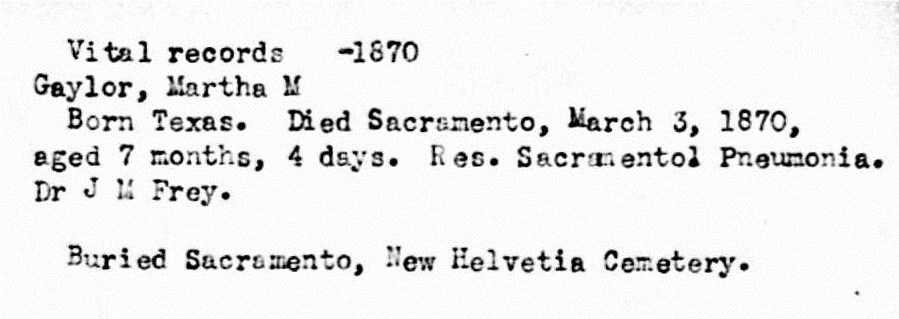
excerpts from that interview as published in the book which give us an idea how dangerous and difficult traveling along that route could be:
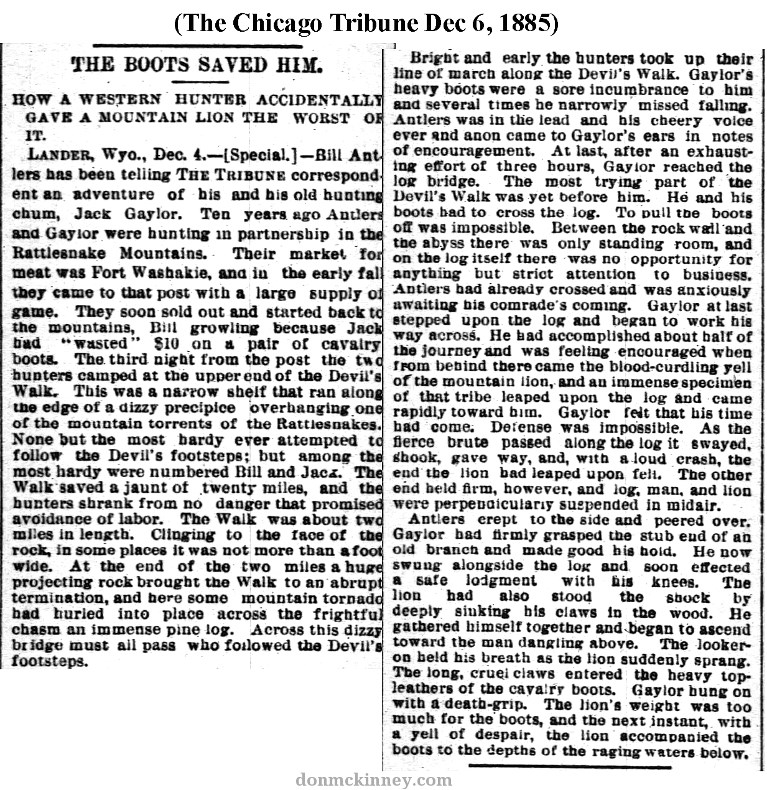
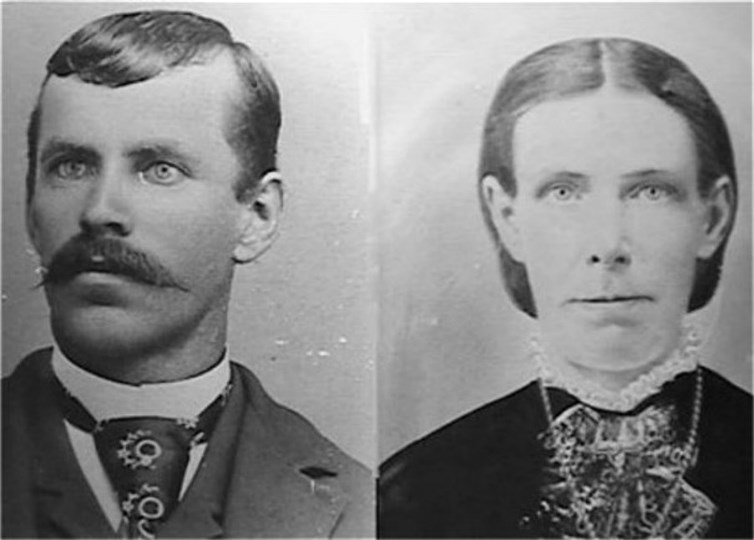
(Photos courtesy of Georgia Hulett & daughter Jean Werts, Dubois, Wyo, descendants of Jack & Sarah's daughter Abbie Gaylor Rhodes)
"A,J. Gaylor is building an extensive addition to his already very comfortable dwelling at the mouth of Popo Appie Canyon. Jacob Frey will do the mechanical work. The process of erection began last Monday."
"A.J. Gaylor's new house is rapidly approaching completion. His experienced and skilled workmen are doing an excellent job and will no doubt come down and hang out their shingles as contractors and builders."
"Jack Gaylor's new residence is about completed. Mr Gaylor now has as comfortable a residence as one could wish."
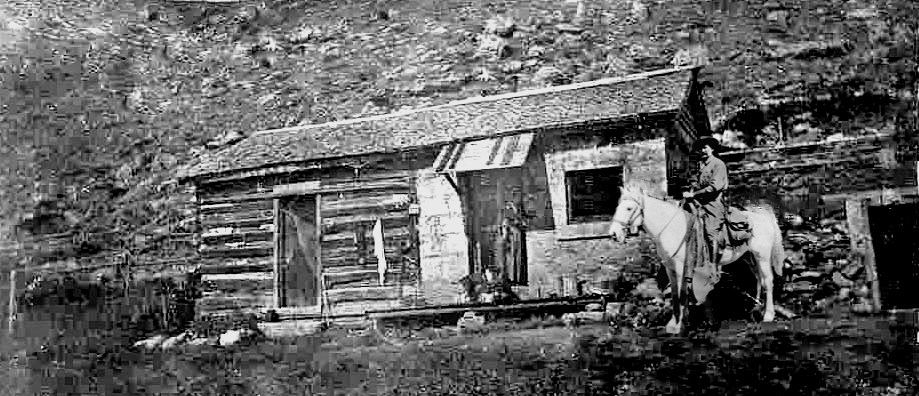
(Photo courtesy of Jack States, descendant of the States family. As the house looked a few years after Gaylor sold it. I used photo software to add Jack Gaylor mounted on a white horse. Per requirements of the homestead, Jack built a log dwelling where he & his family resided. After his wife Sarah died in December 1886, Jack remodeled the log house when neighbor Jacob Frey added a stone room.
H.G. Nickerson purchased the 160 acre homestead from Jack in 1895 and it was later sold to JM Vidal and Eugene Amoretti Jr. in 1899.
It was known as the "States Place" for several decades after Minnie States & her son Herbert States purchased it in 1903. )

"We have always predicted that Fremont County would, in time, become a fruit growing region, which prediction has oft been met by jeers and expressions of unbelief, but the evidence of the fulfillment of the preduction is coming so thick and fast that the oldest "mosback" in the county can no longer gainsay the proof of what has been asserted. Only this week we have laid upon our table ripe apples
as fragrant and luscious as the most exacting could wish. The apples were raised right at the mouth of the Popo Agie Canyon and are of good size and quality. The Siberian crab apples are a beautiful red and of the ordinary size, while the eating apples are of good size and beautiful in appearance. Mr A.J. Gaylor has the honor of raising the apples and Mr John Rogers that of the grapes."

September 17, 1887-"A.J.Gaylor will please accept the thanks of the CLIPPER force for two large delicious watermelons."
February 4, 1888-"A.J. Gaylor was in town Monday. Jack was in a very talkative mood and unbosomed himself of some cold facts which were not very well relished by some of his audience, while others applauded."
August 2, 1888-"A CHALLENGE TO SPELL-J.G. Borner and A.J. Gaylor, two of the patrons of Miss Alden's school, request us to say that they each have a pupil which they will match against any two of like age in Fremont County, for a spelling bee."


Barry, a niece of Mrs James Lynch, one of a fishing party to the Sinks in the Big Popoagie canyon last Tuesday, slipped from a rock into the stream and was drowned before help could reach her. Miss Barry came to Lander some weeks since, intending to spend the summer and perhaps a longer time with her aunt. She had been looking forward with a great deal of pleasant anticipation to the trip to the Sinks and when the party was made up, consisting of Mr and Mrs Lynch, Hattie Baldwin, Mamie McCoy and herself, some entered into the project with more spirit. The most of the day up to five o'clock was spent in fishing and picnicing; at that time the party became somewhat divided, Mr Lynch going to get the team in preparation to coming home, and leaving Miss Barry and Miss McCoy fishing from a large rock a short distance above Jack Gaylor's house. Miss McCoy thinks that while Miss Barry was stepping around her on the rock she must have slipped off backwards, as when she first saw her in the water, she was lying on her back and the water was carrying her down. She at once ran for the rest of the party, some of whom stared for assistance to Gaylor's house while Mr Lynch followed down the stream. He found the body about 200 yards down, just opposite the house, and with the assistance of Mr Gaylor it was gotten out. At this time it was evident that life was extinct; there were numerous bruises on the face and body, and it is not unlikely that being dashed against the rocks by the swift current would have been sufficient of itself to cause her death. The rocks and current at this part of the stream are as bad as at any place in the river, and a strong man would have difficulty in
holding his own were he to slip in. The body, as it was taken out on the side across from Gaylor's house, and the stream at that point could not be forded, had to be taken up that side to the bridge in the canyon, and was there laid in Mr Lynch's buggy and brought home. The funeral services were largely attended yesterday morning, Rev Father Ponsigtione officiating, the interment being made in the Odd Fellows cemetery. The regret for the sad affair is universal, and deep sympathy is expressed for the friends.

This is a "grainy" photo showing how the house looked soon after Jack sold it to Nickerson. I used photo software to add Jack Gaylor standing in front of the entrance that was facing east. I also added the rifle. Sinks Canyon road is behind the house.

(Over 35 years after I wrote the article, I found the following from from the Newspapers web site. The "San Francisco Examiner" dated February 1895 published an article about Jack Gaylor & his "Indian" exploits in Wyoming. This was a month after he sold his sinks canyon homestead in January 1895. The 16 year old "niece" mentioned in the SF article as being escorted there by uncle Jack to attend school, is believed to have been his sister Sarah Matilda Uhls' 19 year old daughter Emma Uhls from Muskogee, Indian Territory who was visiting her Gaylor relatives in Wyoming Oct/Nov 1894. She returned to Muskogee by 1896). There were errors in this article including when Jack arrived in Lander, Wyoming. He did not arrive 29 years prior to the article (1866). He arrived in Cheyenne in 1875 & in the Lander area, Fort Washakie, South Pass about 1880.
Dear Sir - As I am way down here in Florida I would like to have the news, so I will enclose $1 to you, for which you will please send me the CLIPPER. I am one of the boss packers for the Rough Riders. We may stay here for some time as Colonel Torrey is still unable to walk. We have orders to go to Porto Rico, but it is impossible to say when we will move. It is very hot here. We had a bad smashup on our way down here and several of our boys were killed; I was one of the fortunate ones, and only got a bad shaking up in both wrecks. I do not know how I got out, but the first thing I knew I was running like a scared wolf. Well, anyway I did not get killed and I am still in the ring, and I am going to have a mule load of Spaniards' ears before I come back. All of my boys are well at present. George Seton and John Clark, of Embar, are also boss packers, and are experts at their business. We take the long eared mules, with packs, out and drill every day. We expect to pack all of the grub and
ammunition for our regiment. We will stay until the Spanish lads are conquered. There are 18,000 soldiers here and they are still coming. Your truly, A.J. GAYLOR"

Andrew "Jack" Gaylor, chief packmaster with 7th Cavalry, Huntsville, Alabama, 1898
(Photo courtesy of Georgia Hulett & daughter Jean Werts, Dubois, Wyo, descendants of Jack & Sarah's daughter Abbie Gaylor Rhodes)

(Andrew "Jack" Gaylor as civilian packmaster with 7th Cavalry at Camp Force near Huntsville, Alabama, winter 1898--- in December 1898, they moved on to Macon, Georgia before deploying to Pinar del Rio, Cuba in January 1899. He left Wyoming for Florida with "Torrey's Rough Riders" (2d US Volunteer Cavalry), but because of Col Torrey's injuries in a train accident & other issues, that outfit was mustered out & Jack was transferred to the 7th Cavalry.)
"A PRETTY WEDDING IN SOUTH MACON, GEORGIA - We clip the following
from a Macon, Ga., paper of January 12th, which will be of great interest to many of the people of this section of the country."
"A marriage occurred in South Macon last night with just a tinge of romance about it. The contracting parties were Miss Lizzie Shinholser to Mr A.J. Gaylor, chief packmaster of pack train No. 27, which is attached to the Seventh Cavalry in camp here. The groom is a native of Lander, Wyoming. He came to Macon with the Seventh Cavalry, and shortly after arriving here met the young lady who subsequently consented to be his bride. The ceremony was performed in a parlor at the bride's parents in South Macon last night at 8 o'clock, Rev. T.I. Nease officiating.
Mr Gaylor has spent most of his life on the plains, and as he stated last night, felt more at ease in a buckskin suit on the alkali plains of Wyoming than he did in a dress suit. The bride is a sister of Mr Ed Shinholser and was one of the most popular young ladies in that community. After the ceremony a party of friends of the bride serenaded the happy couple."

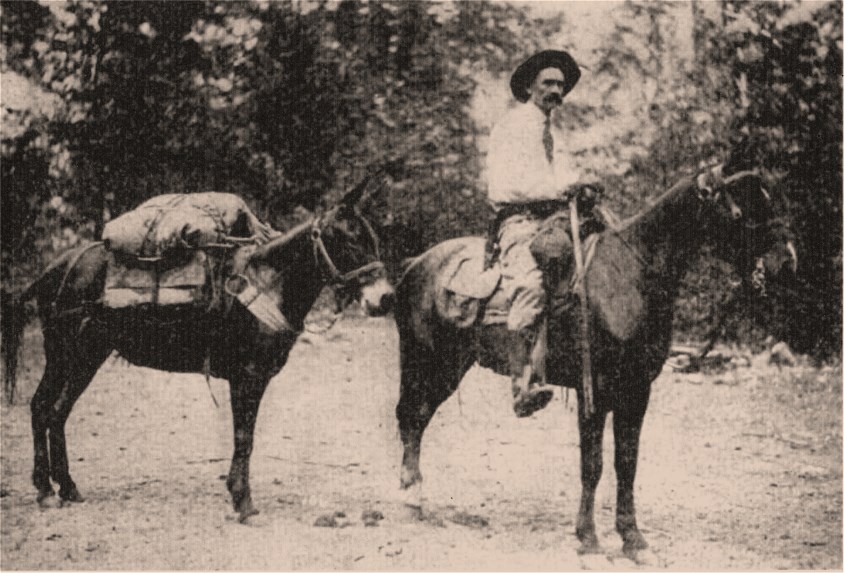
Assistant Chief Park Ranger Andrew "Jack Gaylor. Yosemite National Park
(Grainy photo from Sunset Magazine, The Pacific Monthly 1919)
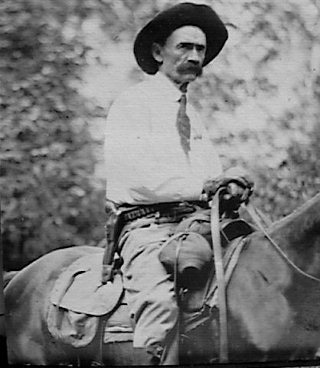
(Photo from Department of Interior, Civilian Personnel Records Center, St Louis, Missouri)
"Beginning in 1898 a few forest rangers (afterwards called park rangers) had been employed, but it was not until 1914 that a permanent ranger force was established. Among these "First Rangers" were Charles Leidig, Archie Leonard, Henry Skelton and Jack Gaylor, who established a fine tradition of devoted public service."
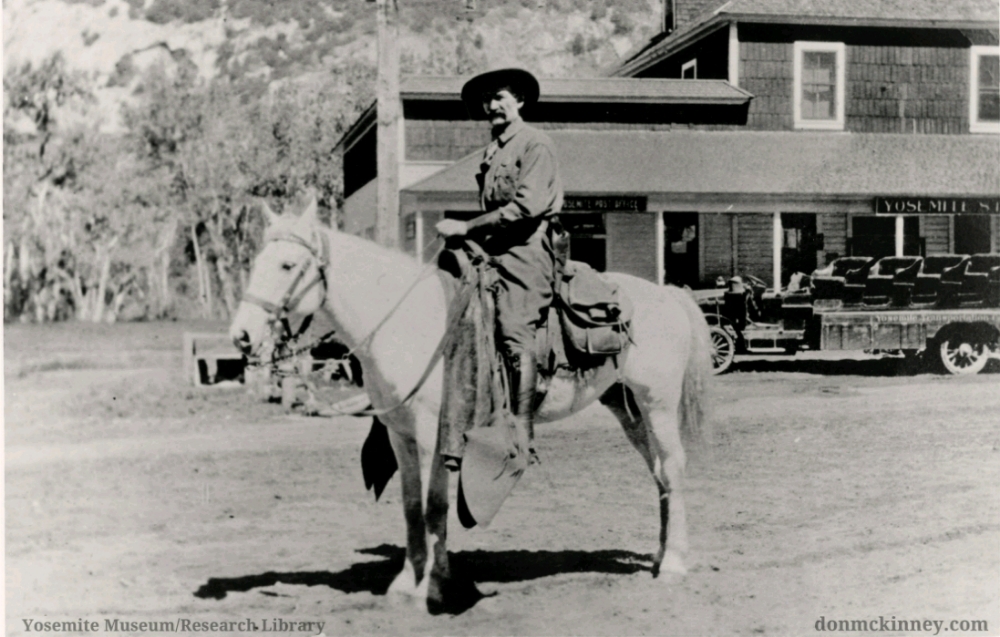
Andrew "Jack" Gaylor, Assistant Chief Park Ranger, Yosemite National Park, about 1915
(Photo from Yosemite Museum/Research Library, Yosemite National Park)
""---------------In 1916 he became Assistant Chief Ranger under Chief Ranger Forest Townsley. At that time there were seven permanent rangers and nineteen temporary rangers. --------------In the spring of 1921 he contracted flue which left
him in a weakened condition. He died of a heart ailment at Merced Lake RangerStation the night of April 19, 1921 while sitting before his campfire. He was on a high mountain patrol and died with his boots on just as he would have wanted it. -----------------Andy Swartz a young bookkeeper for the Park Service was with him when he died. His last ride was down his favorite trail, across his saddle horse with both ends tied down. ------------------I remember him very well, patroling the trails, always on the watch for law violators and forest fires. He always carried a 45 Colt revolver, and a Winchester Carbine and rode a fine mule for many years. Jack truly
was an outstanding person and a real credit to the service."


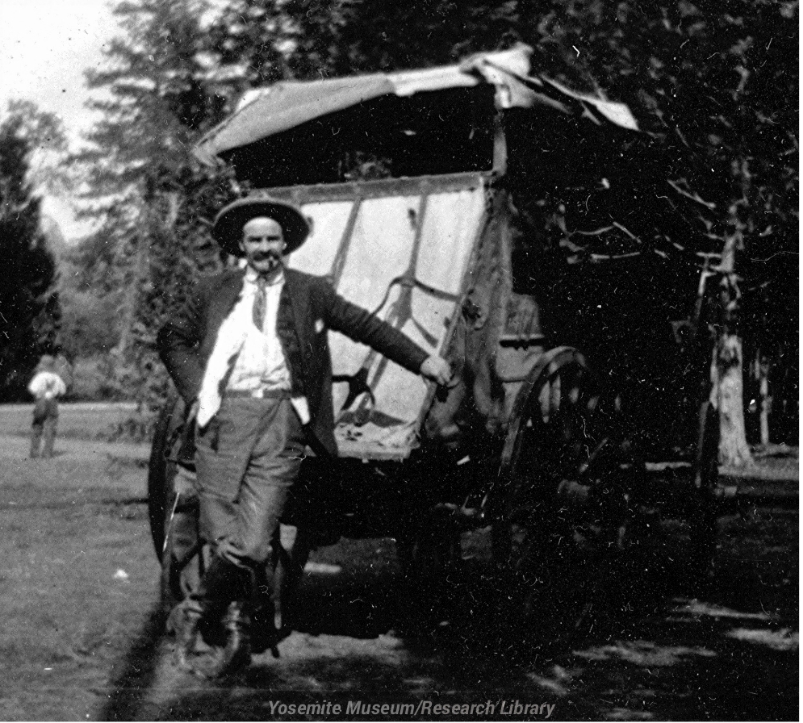
Andrew "Jack" Gaylor, Assistant Chief Park Ranger, Yosemite National Park, about 1919
(Photo from Yosemite Museum/Research Library, Yosemite National Park)
Excerpts: "- - - - -The two articles by your cousin Don were very enjoyable and by chance, I ran into a fellow up here who knows more stories about Jack Gaylor. He is Jerry Mernin, the district park ranger located at the south entrance. Seems he grew up in YOSEMITE NP where his dad was a ranger, and Jack Gaylor was his idol from the stories about him. A mutual friend had a Winchester of Jack's that Jerry coveted, but was never able to obtain as it was given to the park (at Yosemite). Jerry mentioned one story about Jack ordering a car to stop at one of the gates, and when they didn't, he leaped on his horse and upon catching up, shot the tires out on one side. Then to be sure, he rode around the other side and shot out the tires there.- - - - - -"
Yosemite Valley (Weekly News Notes) excerpt: "- - - - - -on the occasion of the fancy dress ball at the Sentinel Hotel. - - - - Such a pageant Yosemite's social life has not seen before. Even the grizzled old veteran ranger, who in his long career has five times been shot, even he, Jack Gaylor, was a part of the gorgeous whole.- - - - - -"

Assistant Chief Park Ranger Andrew "Jack" Gaylor, Yosemite National Park
(Photo purchased on Ebay & on the back was written "Dead Shot Jack" Gaylor, 1921)
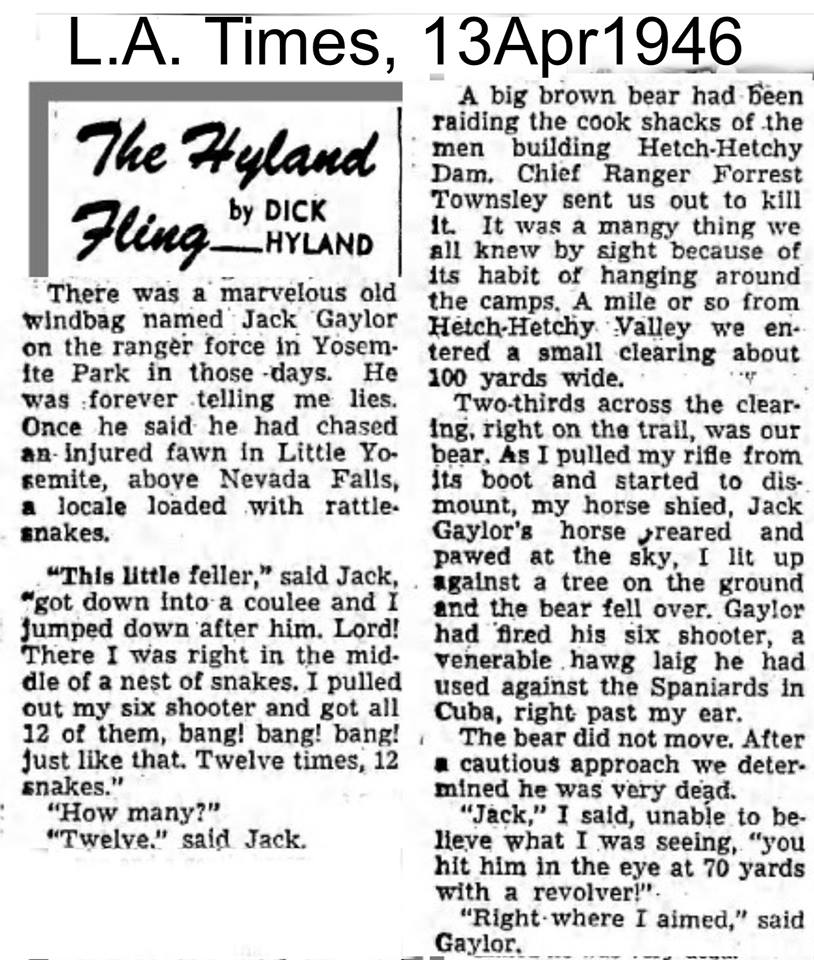
(In this 1946 article for the Los Angeles Times, Dick Hyland recalled his experiences in 1919 as a youth with our ancestor Andrew "Jack" Gaylor who was Asst Chief Park Ranger in Yosemite at that time. During his colorful life, Jack Gaylor was nicknamed "Cherokee Jack", "Deadshot Jack" & "Sureshot Jack". Perhaps he was typical of many "old timers" who enjoyed telling "tall tales" about their experiences on the frontier. Possibly, the writers & reporters were still influenced by Buffalo Bill, Ned Buntline & dime novelists of previous decades who slightly? "exaggerated" various exploits as told to them by some colorful "old timers" of the day. Anyway, concerning Dick Hyland's article here, ol' Jack either reloaded his 6 shooter "hogleg" twice, had two hoglegs or he was full of Irish "blarny" as he described shooting that nest of rattlesnakes. (chuckle, chuckle).
Also, when Jack's horse fully reared & was "pawing at the sky" during that bear encounter, I wonder if ol' Jack was actually aiming at the bear's eye when he shot him? (hummhh)
"ASST CHIEF RANGER DIES IN YOSEMITE NATIONAL PARK - A.J. Gaylor,
assistant chief ranger in Yosemite National Park, died suddenly at Merced Lakes Tuesday, April 19. The body will be brought to Merced for burial Thursday, April 21, and will be accompanied by Mrs Gaylor who was in Yosemite at the time of his death. The time for the funeral will not be fixed until the arrival of the body in Merced and will be under the auspices of Yosemite Lodge No. 30, Knights of Pythias, Mr Gaylor having been a member of Phoenix Lodge No. 4 of San Francisco."

Assistant Chief Park Ranger Andrew "Jack" Gaylor (3d from the left)
(Photo from Yosemite Museum/Research Library, Yosemite National Park)
THIS PAGE & MY ENTIRE FAMILY HISTORY DOMAIN IS PROTECTED BY AWARD WINNING "SITELOCK SECURE".
I PAY A MONTHLY FEE FOR THIS PROTECTION vs A SSL CERTIFICATE.